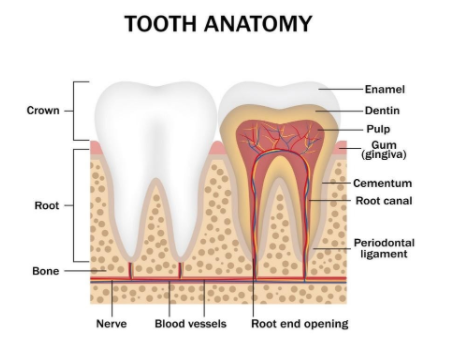
The hard chewing surface of teeth is made of
A. Enamel
B. Dentine
C. Pulp
D. None of the above
Answer
585.9k+ views
Hint: Enamel is the most mineralized tissue of the body, which is why it is considered to be the hardest calcified tissue of the body.
Complete answer:Enamel covers the entire anatomic crown of the tooth forming a translucent layer. It varies in thickness and hardness on each tooth and even from one person to another. It can also vary in color ranging from a yellowish tint to grayish white.
It is the enamel’s hardness that enables teeth to withstand blunt, heavy forces. Enamel is so hard as it mainly has inorganic materials: approximately 95% to 98% of it is calcium and phosphate ions that make up strong hydroxyapatite crystals.
However, these are not pure crystals, because they are carbonated and contain trace minerals such as strontium, magnesium, lead, and fluoride. Almost 1% to 2% of enamel has organic materials, particularly proteins called ‘enamelins’, which have a high affinity for binding the hydroxyapatite crystals. The remainder of enamel is made up of water (about 4% of its net composition).
Enamel is secreted by epithelial cells known as ameloblasts.
The ameloblasts are broken down when a tooth starts growing through the gums, removing enamel’s ability to regenerate or repair itself.
This implies that in case the enamel is damaged by any injury or decay, it can’t be restored.

So, the correct answer is A. Enamel.
Note:The enamel has no blood or nerve supply within it and it insulates us from feeling any kind of pain and sensitivity.
Complete answer:Enamel covers the entire anatomic crown of the tooth forming a translucent layer. It varies in thickness and hardness on each tooth and even from one person to another. It can also vary in color ranging from a yellowish tint to grayish white.
It is the enamel’s hardness that enables teeth to withstand blunt, heavy forces. Enamel is so hard as it mainly has inorganic materials: approximately 95% to 98% of it is calcium and phosphate ions that make up strong hydroxyapatite crystals.
However, these are not pure crystals, because they are carbonated and contain trace minerals such as strontium, magnesium, lead, and fluoride. Almost 1% to 2% of enamel has organic materials, particularly proteins called ‘enamelins’, which have a high affinity for binding the hydroxyapatite crystals. The remainder of enamel is made up of water (about 4% of its net composition).
Enamel is secreted by epithelial cells known as ameloblasts.
The ameloblasts are broken down when a tooth starts growing through the gums, removing enamel’s ability to regenerate or repair itself.
This implies that in case the enamel is damaged by any injury or decay, it can’t be restored.

So, the correct answer is A. Enamel.
Note:The enamel has no blood or nerve supply within it and it insulates us from feeling any kind of pain and sensitivity.
Recently Updated Pages
Two men on either side of the cliff 90m height observe class 10 maths CBSE

Cutting of the Chinese melon means A The business and class 10 social science CBSE

Show an aquatic food chain using the following organisms class 10 biology CBSE

How is gypsum formed class 10 chemistry CBSE

If the line 3x + 4y 24 0 intersects the xaxis at t-class-10-maths-CBSE

Sugar present in DNA is A Heptose B Hexone C Tetrose class 10 biology CBSE

Trending doubts
Why is there a time difference of about 5 hours between class 10 social science CBSE

What is the median of the first 10 natural numbers class 10 maths CBSE

Indias first jute mill was established in 1854 in A class 10 social science CBSE

Indias first jute mill was established in 1854 in A class 10 social science CBSE

Write a letter to the principal requesting him to grant class 10 english CBSE

The Equation xxx + 2 is Satisfied when x is Equal to Class 10 Maths




